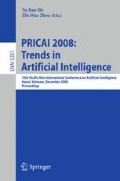Abstract
Recognising daily activity patterns of people from low-level sensory data is an important problem. Traditional approaches typically rely on generative models such as the hidden Markov models and training on fully labelled data. While activity data can be readily acquired from pervasive sensors, e.g. in smart environments, providing manual labels to support fully supervised learning is often expensive. In this paper, we propose a new approach based on partially-supervised training of discriminative sequence models such as the conditional random field (CRF) and the maximum entropy Markov model (MEMM). We show that the approach can reduce labelling effort, and at the same time, provides us with the flexibility and accuracy of the discriminative framework. Our experimental results in the video surveillance domain illustrate that these models can perform better than their generative counterpart (i.e. the partially hidden Markov model), even when a substantial amount of labels are unavailable.
Access this chapter
Tax calculation will be finalised at checkout
Purchases are for personal use only
Preview
Unable to display preview. Download preview PDF.
References
Brand, M., Oliver, N., Pentland, A.: Coupled hidden Markov models for complex action recognition. In: Proc. CVPR, pp. 994–999 (1997)
Bui, H.H., Venkatesh, S., West, G.: Policy recognition in the abstract hidden Markov model. Journal of Articial Intelligence Research 17, 451–499 (2002)
Lafferty, J., McCallum, A., Pereira, F.: Conditional Random Fields: Probabilistic Models for Segmenting and Labeling Sequence Data. In: Proc. ICML, pp. 282–289 (2001)
Liao, L., Fox, D., Kautz, H.: Location-Based Activity Recognition using Relational Markov Networks. In: Proc. IJCAI, pp. 773–778 (2005)
McCallum, A., Freitag, D., Pereira, F.: Maximum Entropy Markov models for information extraction and segmentation. In: Proc. ICML, pp. 591–598 (2000)
Morency, L.P., Quattoni, A., Darrell, T.: Latent-Dynamic Discriminative Models for Continuous Gesture Recognition. In: Proc. CVPR, pp. 1–8 (2007)
Oliver, N., Garg, A., Horvitz, E.: Layered representations for learning and inferring office activity from multiple sensory channels. CVIU 96, 163–180 (2004)
Scheffer, T., Wrobel, S.: Active learning of partially labelled Markov models. In: Active Learning, Database Sampling, Experimental Design: Views on Instance Selection, Workshop at ECML 2001/PKDD 2001 (2001)
Sminchisescu, C., Kanaujia, A., Metaxas, D.: Conditional models for contextual human motion recognition. CVIU 104, 210–220 (2006)
Vail, D.L., Veloso, M.M., Lafferty, J.D.: Conditional random fields for activity recogntion. In: Proc. AAMAS (2007)
Wu, T., Lian, C., Hsu, J.Y.: Joint Recognition of Multiple Concurrent Activities using Factorial Conditional Random Fields. In: AAAI Workshop on Plan, Activity, and Intent Recognition (2007)
Yamato, J., Ohya, J., Ishii, K.: Recognizing human action in time-sequential images using hidden Markov models. In: Proc. CVPR (1992), pp. 379–385 (1992)
Author information
Authors and Affiliations
Editor information
Editors and Affiliations
Rights and permissions
Copyright information
© 2008 Springer-Verlag Berlin Heidelberg
About this paper
Cite this paper
Truyen, T.T., Bui, H.H., Phung, D.Q., Venkatesh, S. (2008). Learning Discriminative Sequence Models from Partially Labelled Data for Activity Recognition. In: Ho, TB., Zhou, ZH. (eds) PRICAI 2008: Trends in Artificial Intelligence. PRICAI 2008. Lecture Notes in Computer Science(), vol 5351. Springer, Berlin, Heidelberg. https://doi.org/10.1007/978-3-540-89197-0_84
Download citation
DOI: https://doi.org/10.1007/978-3-540-89197-0_84
Publisher Name: Springer, Berlin, Heidelberg
Print ISBN: 978-3-540-89196-3
Online ISBN: 978-3-540-89197-0
eBook Packages: Computer ScienceComputer Science (R0)

